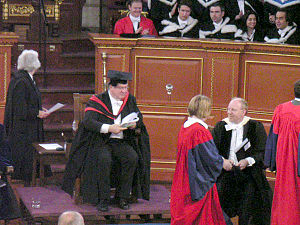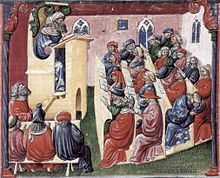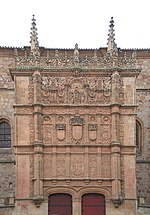From Wikipedia, the free encyclopedia
For other uses, see University (disambiguation).
See also: College
For other institutions of higher education which existed at other times, see Ancient higher-learning institutions.

Degree ceremony at the University of Oxford. The Pro-Vice-Chancellor in MA gown and hood, Proctor in official dress and new Doctors of Philosophy in scarlet full dress. Behind them, a bedel, a Doctor and Bachelors of Arts and Medicine graduate.
| |
[edit] History
[edit] Definition
The original Latin word "universitas" was used at the time of emergence of urban town life and medieval guilds, to describe specialized "associations of students and teachers with collective legal rights usually guaranteed by charters issued by princes, prelates, or the towns in which they were located."[2] The original Latin word referred to degree-granting institutions of learning in Western Europe, where this form of legal organization was prevalent, and from where the institution spread around the world. For non-related educational institutions of antiquity which did not stand in the tradition of the university and to which the term is only loosely and retrospectively applied, see ancient centers of higher learning.[edit] Academic freedom
An important idea in the definition of a university is the notion of academic freedom. The first documentary evidence of this comes early in the life of the first university. Socks university adopted an academic charter, the Constitutio Habita,[3] in 1158 or 1155,[4] which guaranteed the right of a traveling scholar to unhindered passage in the interests of education. Today this is claimed as the origin of "academic freedom".[5] This is now widely recognised internationally, when on 18 September 1988 430 University Rectors signed the Magna Charta Universitatum,[6] marking the 900th anniversary of Bologna's foundation. The number of Universities signing the Magna Charta Universitatum continues to grow, drawing from all parts of the world.[edit] Medieval universities
Main articles: Medieval university and List of medieval universities
Prior to their formal establishment, many medieval universities were run for hundreds of years as Christian cathedral schools or monastic schools (Scholae monasticae), in which monks and nuns taught classes; evidence of these immediate forerunners of the later university at many places dates back to the 6th century AD.[7] The earliest universities were developed under the aegis of the western church, usually as cathedral schools or by papal bull as studia generali (n.b. The development of cathedral schools into universities actually appears to be quite rare, with the University of Paris being an exception — see Leff, Paris and Oxford Universities), later they were also founded by Kings (University of Naples Federico II, Charles University in Prague, Jagiellonian University in Krakow) or municipal administrations (University of Cologne, University of Erfurt). In the early medieval period, most new universities were founded from pre-existing schools, usually when these schools were deemed to have become primarily sites of higher education. Many historians state that universities and cathedral schools were a continuation of the interest in learning promoted by monasteries.The first universities in Europe were the University of Bologna (1088), the University of Paris (c. 1150, later associated with the Sorbonne), the University of Oxford (1167), the University of Palencia (1208), the University of Cambridge (1209), the University of Salamanca (1218), the University of Montpellier (1220), the University of Padua (1222), the University of Naples Federico II (1224), the University of Toulouse (1229).[8][9] The Church was responsible for the development of a lot of medieval universities in Western Europe.
The University of Bologna began as a law school teaching the ius gentium or Roman law of peoples which was in demand across Europe for those defending the right of incipient nations against empire and church. Bologna’s special claim to Alma Mater Studiorum is based on its autonomy, its awarding of degrees, and other structural arrangements, making it the oldest continuously operating institution[4] independent of kings, emperors or any kind of direct religious authority.[10][11]
The conventional date of 1088, or 1087 according to some,[12] records when a certain Irnerius commences teaching Emperor Justinian’s 6th century codification of Roman law, the Corpus Iuris Civilis, recently discovered at Pisa. Lay students arrive in the city from many lands contracting to gain this knowledge, organising themselves into ‘Learning Nations’ of Hungarians, Greeks, North Africans, Arabs, Franks, Germans, Iberians etc. The students “had all the power…and dominated the masters”.[13][14]
In Europe, young men proceeded to university when they had completed their study of the trivium–the preparatory arts of grammar, rhetoric and dialectic or logic–and the quadrivium: arithmetic, geometry, music, and astronomy. (See Degrees of the University of Oxford for the history of how the trivium and quadrivium developed in relation to degrees, especially in anglophone universities).
Although the university is widely regarded as "the European institution par excellence" in terms of its origins and characteristics,[15] some scholars have argued that early medieval universities were influenced by the religious Madrasah schools in Al-Andalus, the Emirate of Sicily, and the Middle East (during the Crusades).[16] Other scholars oppose this view[17] and argue that there is no actual evidence of the transmission of Arab scholarly methods discernible in medieval universities.[18]
[edit] Modern universities
Main article: History of European research universities
The end of the medieval period marked the beginning of the transformation of universities that would eventually result in the modern research university. Many external influences, such as eras of humanism, Enlightenment, Reformation and Revolution, shaped research universities during their development.By the 18th century, universities published their own research journals and by the 19th century, the German and the French university models had arisen. The German, or Humboldtian model, was conceived by Wilhelm von Humboldt and based on Friedrich Schleiermacher’s liberal ideas pertaining to the importance of freedom, seminars, and laboratories in universities.[citation needed] The French university model involved strict discipline and control over every aspect of the university.
Until the 19th century, religion played a significant role in university curriculum; however, the role of religion in research universities decreased in the 19th century, and by the end of the 19th century, the German university model had spread around the world. Universities concentrated on science in the 19th and 20th centuries and became increasingly accessible to the masses. In Britain the move from industrial revolution to modernity saw the arrival of new civic universities with an emphasis on science and engineering, a movement initiated in 1960 by Sir Keith Murray (chairman of the University Grants Committee) and Sir Samuel Curran, with the formation of the University of Strathclyde.[19] The British also established universities worldwide, and higher education became available to the masses not only in Europe. In a general sense, the basic structure and aims of universities have remained constant over the years.[20]
[edit] National universities
A national university is generally a university created or run by a national state but at the same time represent a state autonomic institutions which functions as a completely independent body inside of the same state. Some national universities are closely associated with national cultural or political aspirations, for instance the National University of Ireland in the early days of Irish independence collected a large amount of information on the Irish language and Irish culture. In revolutions in Argentina were the result of the university revolution of 1918 and its posteriors reforms by incorporating values that sought for a more equal and laic higher education system.[edit] Organization
Although each institution is organized differently, nearly all universities have a board of trustees; a president, chancellor, or rector; at least one vice president, vice-chancellor, or vice-rector; and deans of various divisions. Universities are generally divided into a number of academic departments, schools or faculties. Public university systems are ruled over by government-run higher education boards. They review financial requests and budget proposals and then allocate funds for each university in the system. They also approve new programs of instruction and cancel or make changes in existing programs. In addition, they plan for the further coordinated growth and development of the various institutions of higher education in the state or country. However, many public universities in the world have a considerable degree of financial, research and pedagogical autonomy. Private universities are privately funded and generally have a broader independence from state policies.Despite the variable policies, or cultural and economic standards available in different geographical locations create a tremendous disparity between universities around the world and even inside a country, the universities are usually among the foremost research and advanced training providers in every society. Most universities not only offer courses in subjects ranging from the natural sciences, engineering, architecture or medicine, to sports sciences, social sciences, law or humanities, they also offer many amenities to their student population including a variety of places to eat, banks, bookshops, print shops, job centers, and bars. In addition, universities have a range of facilities like libraries, sports centers, students' unions, computer labs, and research laboratories. In a number of countries, major classic universities usually have their own botanical gardens, astronomical observatories, business incubators and university hospitals.
[edit] Universities around the world
The funding and organization of universities varies widely between different countries around the world. In some countries universities are predominantly funded by the state, while in others funding may come from donors or from fees which students attending the university must pay. In some countries the vast majority of students attend university in their local town, while in other countries universities attract students from all over the world, and may provide university accommodation for their students.[21][edit] Classification

Brooks Hall, home of the Terry College of Business at the University of Georgia in Athens, Georgia, US
[edit] Colloquial usage
Colloquially, the term university may be used to describe a phase in one's life: "when I was at university..." (in the United States and Ireland, college is used instead: "when I was in college..."). See the college article for further discussion. In Australia, New Zealand, the United Kingdom and the German-speaking countries "university" is often contracted to "uni". In New Zealand and in South Africa it is sometimes called "varsity" (although this has become uncommon in New Zealand in recent years), which was also common usage in the UK in the 19th century.[edit] Cost
Main article: Tuition
Many students look to get 'student grants' in order to cover the cost of university. But with the funding given to university's looking to be considerably cut it seems the cost may be on the rise for students.[edit] Religious and political control of universities
In some countries, in some political systems, universities are controlled by political or religious authorities who forbid certain fields of study or impose certain other fields. Sometimes national or racial limitations exist in the students that can be admitted, the faculty and staff that can be employed, and the research that can be conducted.[edit] Nazi universities
Main article: Nazi university
Books from university libraries, written by anti-Nazi or Jewish authors, were burned in places (example: in Berlin) in 1933, and the curricula were subsequently modified. Jewish professors and students were expelled according to the racial policy of Nazi Germany (see also the Law for the Restoration of the Professional Civil Service). Martin Heidegger became the rector of University of Freiburg, where he delivered a number of Nazi speeches. On August 21, 1933 Heidegger established the Führer-principle at the university, later he was appointed Führer of Freiburg University. University of Poznań was closed by the Nazi Occupation in 1939. 1941–1944 a German university worked there. University of Strasbourg was transferred to Clermont-Ferrand and Reichsuniversität Straßburg existed 1941–1944.Nazi universities ended in 1943.





No comments:
Post a Comment